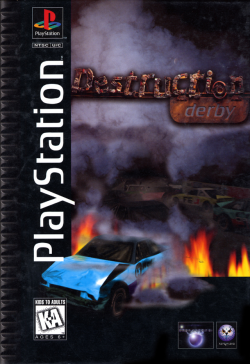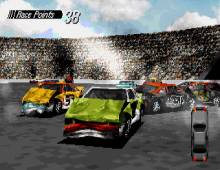Critical
Writing for GamePro , Captain Squideo called Destruction Derby "the most raucous racing experience of the fall". He believed that its "graphics are almost all you could want for a game" of this type, but wrote that "nothing here stands out as graphically spectacular". He complained that the game does not let players customise cars, and he disliked its lack of split-screen multiplayer. He summarised, "Limited options keep Destruction Derby out of the winner's circuit, but this rowdy stock-car racer still generates a stadium full of thrashin' fun." [33] Victor Lucas of The Electric Playground stated that "the beauty of the game" is the strategy involved in making "calculated strikes" against enemy vehicles, and he wrote, "If you go all out and try to make big noise on the track, more than likely you'll be limping to the scrap yard in seconds." He believed that the game's Stock Car racing mode "is no match for the white knuckle inertia of either Wipeout or Ridge Racer", and that the demolition derbies in The Bowl were "most fun to be had" in the game. He praised the game's graphics and physics, and concluded, "Destruction Derby is a winner in every capacity." [8] A reviewer for Next Generation was extremely pleased with the concept of smashing into other cars, saying it taps into a near-universal fantasy. He remarked the single-player mode is indefinably "lacking" but the multiplayer offers unqualified enjoyment. [29] The IGN reviewer commented that the controls are "way, way too loose". [28]
The PC port was also well received. Lee Buchanan of PC Gamer US praised "the spectacular visuals that bring to life the most jarring collisions I've seen on a computer", and he noted that "[car] damage is depicted beautifully". Like Lucas, he wrote that the player "can't just mindlessly smash into other cars; this is thinking man's destruction". Although he found the game too easy "even at the toughest difficulty level", he found this to be a minor issue that did not detract from the experience. He considered the game's online play to be a high point, and he finished, "Destruction Derby is a blast, and a welcome change of pace from high-end driving simulations." [9] Peter Olafson of Computer Gaming World called the game "a great simulation" of demolition derbies, and he wrote that the wrecks are "convulsive and realistic". He believed that the game "has never-before-seen quality that will instantly make it a showpiece game to demonstrate to open-mouthed friends and relatives", and he considered the car damage to be "especially marvelous—and unprecedented for this sort of game". However, he found that its "useful life span is surprisingly short" and he hoped for a track editor in its sequel. He summarised, "Despite its limitations, this is a great game, but it has a lot more potential." [6] A reviewer for Next Generation remarked that while the game is a straight port of the PlayStation version, it is an impeccably accurate one. He applauded the authentic modelling of vehicle crashes, multiple modes, smoothness of gameplay, and inclusion of both network and modem options, and found the game's only downside is that the camera zooms out so little that it can be difficult to see nearby cars. [30] Computer & Video Games said that the port is an "incredible conversion of the PS game which runs easily as fast and with as much detail." [22]
Reviewing the game's Sega Saturn version, Kim Randell of Computer & Video Games noted its "inferior graphics" that do not have "the sheen and glossiness of its PlayStation counterpart". Randell believed that it was made "much too late to cause the kind of sensation that WipEout did. Comparisons with the PlayStation version are inevitable, and the rather haphazard conversion means that the Saturn version lacks the polish of its rival." [23] Rob Allsetter's review in Sega Saturn Magazine (from the same publisher as Computer & Video Games) recycled most of the text from Randell's review, including the closing remarks. [32]
Retrospective
Mike Channell of Top Gear in 2021 called Destruction Derby "technologically impressive" for its time. He further praised the strategic side to the "chaos": "You'd need to use reverse gear for as long as possible to avoid hobbling your radiator immediately". [34] In a 2023 article by IGN as part of their '90s Week, Peer Schneider selected the game as one of three "forgotten launch gems" of the PlayStation, stating "you couldn't ask for a better tech demo to dazzle your friends than showing off 20 cars on screen, peeling out and crashing into each other." [35]

